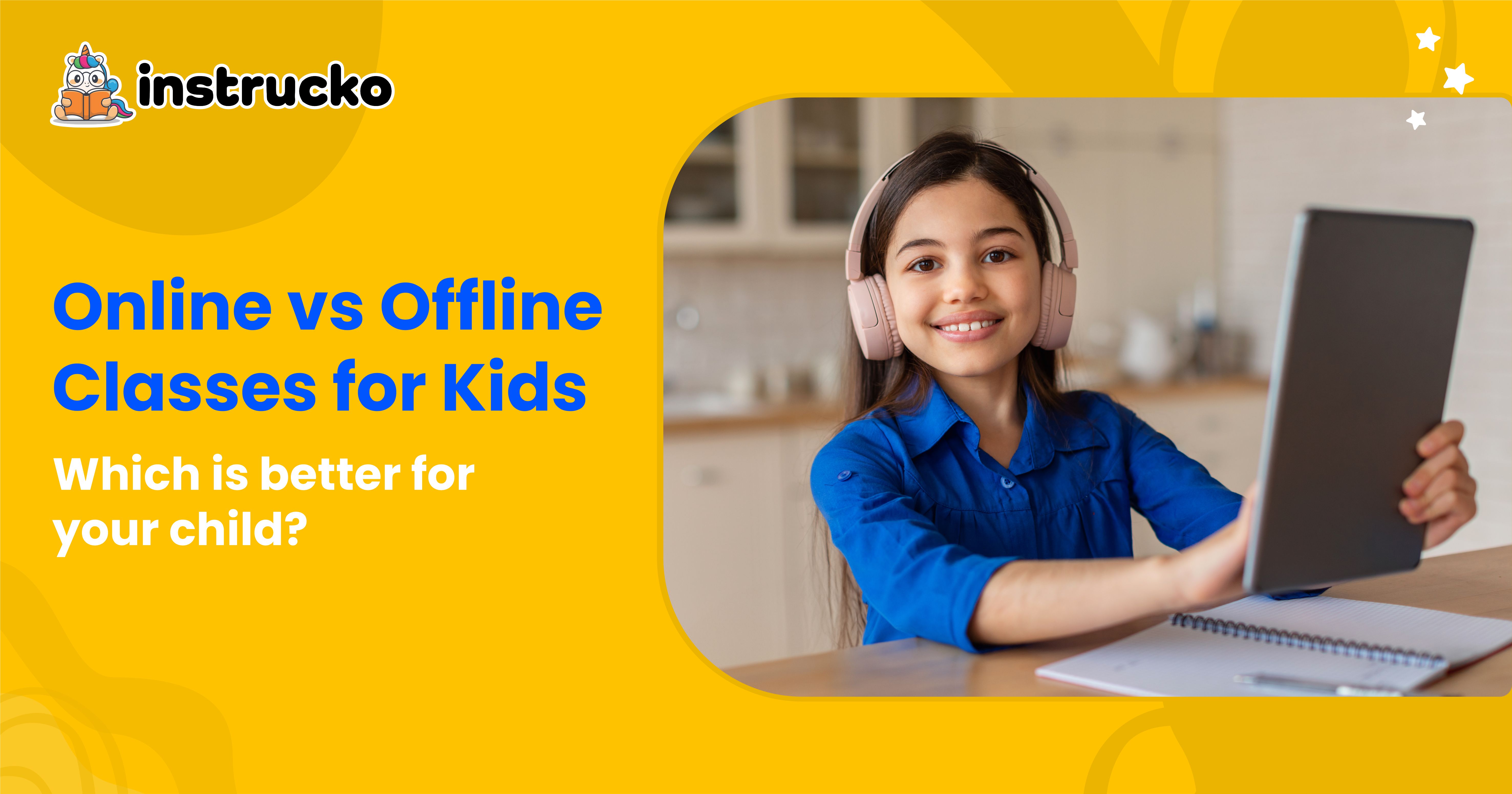The debate between online and offline classes for kids has been ongoing, especially after the surge in virtual learning brought on by the global pandemic. Both formats offer unique advantages, but they also come with their own sets of challenges. So, as a parent, how do you decide which is better for your child? In this blog, we’ll explore the key differences, benefits, and drawbacks of both online and offline classes, helping you make an informed decision.
1. Flexibility vs Structure
Online Classes
One of the most significant advantages of online classes is the flexibility they offer. Children can attend lessons from the comfort of their home, saving time and energy spent commuting to school. Additionally, many online learning platforms offer recorded lessons, allowing kids to revisit tricky concepts or catch up if they missed a class.
This flexibility is particularly beneficial for children with busy schedules or those participating in extracurricular activities like sports or music lessons. Online classes make it easier to balance academics with other interests.
Offline Classes
Offline (traditional) classes, on the other hand, follow a more rigid schedule. Classes happen at fixed times, and children must be present in the classroom. While this structure provides a sense of routine and discipline, it might not always accommodate a child’s individual pace of learning.
For kids who thrive in routine and structured environments, offline classes provide a set daily rhythm that keeps them organised and focused.
2. Personalised Learning vs Group Interaction
Online Classes
One of the major strengths of online classes is the ability to tailor the learning experience to each child’s needs. Platforms like Instrucko offer small class sizes or even 1:1 sessions, which provide individual attention to the child. Personalised feedback and lesson adjustments ensure that children learn at their own pace and grasp concepts fully before moving on.
This personalised approach is ideal for children who may struggle in larger classrooms or those with specific learning needs. For example, online classes can cater to various learning styles—whether a child is a visual, auditory, or kinesthetic learner.
Offline Classes
While offline classes may not offer the same level of individual attention, they provide valuable opportunities for social interaction. Learning in a classroom environment allows children to engage with their peers, develop communication skills, and experience teamwork through group projects or discussions.
This social aspect can be especially crucial for younger children who are still learning how to navigate social dynamics, make friends, and collaborate with others.
3. Engagement and Focus
Online Classes
Many parents worry that online classes may lead to decreased engagement, with distractions like toys, pets, or even other family members nearby. However, high-quality online platforms use interactive tools like quizzes, games, and virtual whiteboards to keep students engaged.
The key is to ensure that the online learning environment is set up for success. Creating a dedicated study space, minimising distractions, and ensuring reliable internet access can help kids stay focused during lessons.
Offline Classes
In a traditional classroom, teachers can monitor children’s behaviour and engagement more closely, ensuring they stay focused on the lesson. The physical presence of a teacher and classmates often acts as a motivator for many kids, pushing them to stay attentive.
However, offline classes may also mean that lessons are paced uniformly, making it challenging for children who may need more time on certain subjects or find others too slow.
4. Access to Resources
Online Classes
Online learning opens up a world of resources that might not be available in a traditional classroom. Interactive lessons, educational videos, and virtual field trips are just a few examples of how online platforms make learning more dynamic and exciting.
Additionally, online classes offer access to expert educators from around the world. A child in a small town could be learning English from a teacher based in the UK or Mathematics from a specialist in another country, expanding their horizons far beyond the walls of a local classroom.
Offline Classes
Offline classes have their own set of tangible resources like textbooks, science labs, and physical materials that children can use to learn. Hands-on experiments, for instance, can be more impactful when done in a real lab setting under the guidance of a teacher. Similarly, subjects like art and physical education may feel more engaging in an offline environment where kids can physically interact with tools and equipment.
5. Safety and Health
Online Classes
One of the clear advantages of online learning is the safety aspect. With the ongoing concerns about health in crowded spaces, learning from home keeps children safe from exposure to illnesses.
Additionally, online classes allow children to maintain their mental well-being by learning in a familiar and comfortable environment. For kids who experience anxiety or stress in traditional school settings, online classes can provide a much-needed sense of security.
Offline Classes
Offline classes offer opportunities for physical activity, especially with subjects like physical education. Children in a traditional classroom can interact more dynamically with their surroundings, participate in outdoor activities, and engage in real-time group activities.
However, the close physical proximity to others also means a higher risk of illnesses spreading, which is a significant concern for parents in today’s world.
6. Cost-Effectiveness
Online Classes
Online classes tend to be more cost-effective than traditional schooling. Parents save on transportation, school uniforms, meals, and sometimes even school supplies. The costs of online classes vary depending on the platform, but they often provide a more affordable alternative for many families.
Many online platforms offer subscriptions or pay-per-class models, allowing parents to choose what suits their budget best.
Offline Classes
While offline classes may have higher costs (including tuition, transportation, and extracurricular fees), they also offer facilities that may not be available online. Sports facilities, science labs, libraries, and art studios are just some of the benefits that traditional schools provide.
Conclusion: Which is Better?
Ultimately, the decision between online and offline classes for kids comes down to your child’s learning style, your family’s needs, and your priorities as a parent.
If your child thrives on flexibility, personalised learning, and a tech-friendly environment, online classes might be the better option.
If your child needs structured routines, social interaction, and hands-on learning experiences, offline classes could be the way to go.
In today’s world, a blend of both formats—hybrid learning—may offer the best of both worlds, providing flexibility while maintaining the social and academic benefits of a traditional classroom.
Whatever you choose, the most important factor is ensuring your child feels supported, engaged, and excited about learning!









